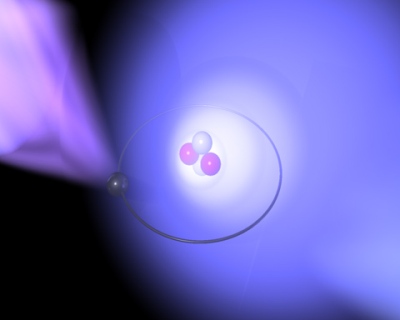Modern cosmology beliefs hold that antimatter and matter existed in equal quantities in the Big Bang when the universe was created. Scientists are developing artificial antimatter atoms to understand the symmetry between antimatter and matter.
A research team, Antimatter Spectroscopy, at the Max Planck Institute of Quantum Optics has measured the antiproton mass with respect to electrons with an accuracy of about 1.3 parts per billion.
 An antiproton (black sphere) trapped inside a helium atom is probed by two laser beams.
An antiproton (black sphere) trapped inside a helium atom is probed by two laser beams.
For this, the researchers utilized a novel laser spectroscopy method to study an atom known as antiprotonic helium which is half-matter and half-antimatter. The obtained result was the same as the measured proton mass to an equal extent of accuracy, affirming the symmetry between antimatter and matter. It is very difficult to deal with antimatter in labs because the moment it comes in contact with ordinary matter, it annihilates and gets converted to new particles and energy. Hence, MPQ researchers utilized a technique known as two-photon laser spectroscopy.
Two beams of laser moving in opposite directions struck the atoms and their effect got cancelled partially, resulting in 4 to 6 times greater accuracy. The first laser beam forced the antiproton to produce a quantum jump to an energy level that is not possible by quantum mechanics. Now, the second laser beam can cause the antiproton to reach the nearest allowed state. Generally, it is difficult to make two photon jumps because of the weight of the antiproton. However, MPQ scientists achieved it by developing two ultra-sharp lasers and carefully selecting a unique blend of laser frequencies. In order to accomplish this, an innovative device called the optical frequency comb was utilized. This device can measure light frequencies.
The measurements obtained revealed that the antiproton is heavier than the electron by 1836.1526736(23) times. The Head of the research group, Masaki Hori stated that they have measured the antiproton mass with respect to electron with an accuracy of 10 digits. They have also found that this value is similar to the proton value with the same precision, he added. The results revealed that antiprotons comply with nonlinear quantum optics laws similar to normal particles and lasers can be utilized to manipulate them, explained Hori.